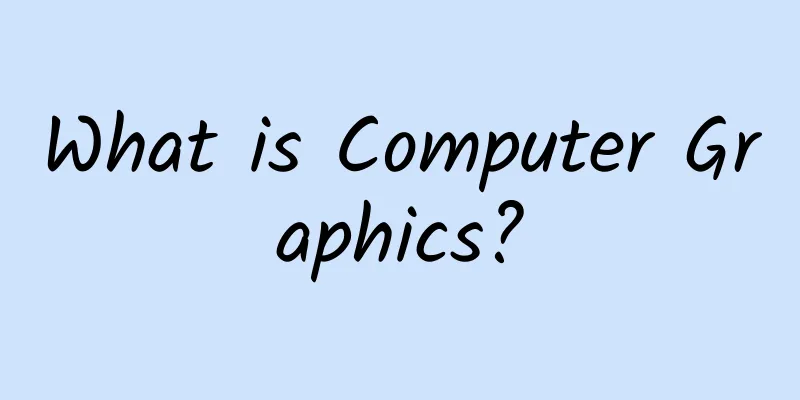What is Computer Graphics?

|
1. What is computer graphics? What is Computer Graphics? Computer Graphics (CG) has a wide range of content and intersects with many disciplines, so I think it is impossible to strictly define it. On Wikipedia and Baidu Encyclopedia, the explanation of "computer graphics" is: Computer graphics is a science that uses mathematical algorithms to convert two-dimensional or three-dimensional graphics into a raster form for computer displays. Simply put, the main research content of computer graphics is to study how to represent graphics in computers, as well as the relevant principles and algorithms for using computers to calculate, process and display graphics. Although CG is generally considered to refer to the processing of three-dimensional graphics, in fact it also includes the processing of two-dimensional graphics and images. In a narrow sense, computer graphics is the inverse process of digital image processing or computer vision: computer graphics is the discipline of drawing images with computers, digital image processing is the discipline of processing images obtained from the outside world with computers, and computer vision is the discipline of understanding and identifying the three-dimensional information and other information of objects based on the acquired images. Note that these are not exact definitions. In fact, the distinctions between computer graphics, digital image processing, and computer vision are not very clear in many places. Many concepts are interlinked, and with the deepening of research, these disciplines are constantly cross-integrated to form a larger discipline, which can be called "Visual Computing". This is a later story and will not be elaborated here. 2. The main content of computer graphics At the beginning of the discipline, computer graphics was about how to represent three-dimensional geometric figures in computers, and how to use computers to generate, process and display related principles and algorithms for graphics, so as to produce pleasing and realistic images. This is the scope of computer graphics in a narrow sense. With the development of nearly 40 years, the content of computer graphics has gone far beyond this. The research content of computer graphics in a broad sense is very extensive, such as graphics hardware, graphics standards, graphics interaction technology, raster graphics generation algorithms, curve and surface modeling, solid modeling, realistic graphics calculation and display algorithms, as well as scientific computing visualization, computer animation, natural scenery simulation, virtual reality, etc. According to my understanding, computer graphics mainly includes four parts: modeling, rendering, animation and human-computer interaction (HCI). 1. Modeling To represent a three-dimensional object in a computer, we must first have its geometric model. Therefore, the modeling of three-dimensional models is the foundation of computer graphics and the premise of other contents. A geometric object can be expressed by mathematical spline functions or implicit functions; it can also be expressed by triangular meshes expressed by sampling points on a smooth surface and their connection relationships (i.e., piecewise linear approximation of a continuous surface), as shown in the figure below. The 3D modeling methods mainly include the following methods: The mainstream method in computer-aided design (CAD) is to use NURBS (non-uniform rational B-splines, Bezier curves and surfaces) method (which has become the standard in the CAD industry), which is also the main content of computer-aided geometric design (CAGD). There are some difficult problems in this expression method that have not been solved, such as smooth splicing of surfaces under irregular conditions, complex surface expression, etc. This part involves a lot of mathematics, and there are more scholars working on this in China. l Subdivision surface modeling method, as a discrete iterative surface construction method, is a hot research topic due to its simple construction process and easy implementation. After more than ten years of research and development, subdivision surface modeling has made great progress, including the continuous construction method at singular points and the surface processing method combined with GPU graphics hardware. l Direct manual modeling using software. The mainstream commercial 3D modeling software now includes Autodesk 3D Max and Maya. There are also commercial software for specific fields, such as Google Sketchup for architectural modeling, CATIA and AutoCAD for CAD/CAM/CAE, SolidWorks for mechanical design, and Rhino for the shipbuilding industry. These software require modelers to have strong professional knowledge and require a certain period of training to master. The modeling efficiency is low and the learning threshold is high. It is not easy to popularize and allow non-professional users to use. l 3D modeling method based on stroke or sketch interaction. Sketch interaction is a hot modeling method in recent years because it conforms to the original thinking habits of human beings in daily life and the interaction method is intuitive and simple. The difficulty lies in how to correctly understand and identify the semantics expressed by the user's interaction according to the specific application scenario and construct the model desired by the user. l Procedural modeling method based on grammar and rules. It is particularly suitable for geometric objects and scenes with repeated features and structure, such as buildings, trees, etc. There have been many papers and great developments in recent years. l Modeling methods based on images or videos. This is the basic problem that traditional computer vision has to solve. In the field of computer graphics, this aspect is also developing rapidly. Some commercial software or cloud services (such as Autodesk's 123D) can already reconstruct the 3D model of the photographed object from several photos. The problem with this method is that the object itself needs to exist, and the accuracy of the reconstructed 3D model is limited. l Modeling (Reconstruction) based on scanning point clouds (depth images such as Kinect, structured light scanning, laser scanning, LiDAR scanning, etc.). With the emergence of depth cameras and the rapid decline in the price of scanners, it has become easier for people to collect 3D data. The work of reconstructing 3D models from the collected 3D point clouds can be seen in Siggraph (Asia) in recent years. However, the simple reconstruction method has the disadvantages of low accuracy, poor stability and large amount of calculation, which is far from meeting the actual needs. l Methods of synthesizing models based on existing models. With the increasing number of 3D models, existing 3D models can be used to splice or synthesize new 3D models through simple operations such as cut and paste, or analysis and deformation. This method of modeling by "learning" the knowledge of the model database has been very popular in the past 3-5 years. In a way, it is a specific manifestation of the field of computer graphics in the context of the "big data era". In addition to the above-mentioned modeling methods, there are other modeling methods, which are not listed here one by one. In the process of building a 3D geometric model, there are many geometric problems that need to be dealt with, such as data denoising or smoothing, repairing, simplification, level of detail, parameterization, deformation or editing, segmentation, shape analysis and retrieval, etc. These problems constitute the main research content of "digital geometry processing". The author has opened a graduate course of "digital geometry processing" for many years since 2005: http://staff.ustc.edu.cn/~lgliu/Courses/DGP_2012_spring-summer/default.htm Although there are so many 3D modeling methods mentioned above, there is still no easy and simple modeling tool suitable for general home users. Existing electronic devices (such as cameras, mobile phones, etc.) can help people easily obtain images and videos, but not everyone has the ability to build 3D geometric models. How to enable the public to obtain or build 3D models anytime and anywhere like obtaining images is still one of the main tasks of computer graphics! Today, computer graphics has not yet entered the "big data era". Only when the public can easily perform 3D modeling and upload and share the model data they have built, can computer graphics enter the big data era. In addition, with the gradual popularization of the emerging technology of 3D printing, people's demand for 3D models is also increasing. I personally believe that the future of geometric modeling and 3D printing is shared: only when everyone can easily model, 3D printing can be introduced to thousands of households. The task of 3D geometric modeling still has a long way to go, and we still need to work together!
2. Rendering With a 3D model or scene, how can we draw these 3D geometric models to produce pleasing and realistic images? This is the core task of traditional computer graphics. In computer-aided design, film and television animation and various visualization applications, high requirements are placed on the high realism of graphics rendering results. There were more studies in the 1980s and 1990s, which included a large number of rendering models, including the Local Illumination Model, Ray Tracing, Radiosity, etc., as well as later more complex, realistic and fast rendering technologies, such as the Global Illumination Model, Photo mapping, BTF, BRDF, and GPU-based rendering technology. Current rendering technology is able to render various objects, including skin, trees, flowers, water, smoke, hair, etc., very realistically. Some commercial software (such as Maya, Blender, Pov Ray, etc.) also provide powerful realistic rendering functions. These tools are often used in computer graphics research papers to render beautiful presentation images or result images. However, the known rendering implementation methods are still unable to achieve complex visual effects, and there is still a big gap from real-time high-realistic rendering, such as the complete implementation of the RenderMan standard suitable for movie rendering (high realism, high resolution) and other real-time rendering algorithms based on physical reality. Therefore, how to make full use of the computing characteristics of GPUs and combine distributed cluster technology to construct low-power rendering services is one of the development trends.
3. Animation Animation is a method of continuously playing still images to produce the effect of object movement. Computer animation generates a series of scene images with the help of programming or animation software, and is one of the research hotspots of computer graphics. Research directions include: human animation, joint animation, motion animation, script animation, animation system of virtual characters with human consciousness, etc. In addition, dynamic simulation with high physical realism, including the real simulation of various physical phenomena such as deformation, water, air, cloud, smoke, burning, explosion, tearing, aging, etc., is also a major problem in the field of animation. These technologies are the core technologies of various dynamic simulation applications and can greatly improve the immersion of virtual reality systems. Computer animation has a wide range of applications, such as cartoon production, advertising, movie stunts, training simulation, physical simulation, games, etc. Some 3D animation videos on the Internet: Larva: http://v.youku.com/v_show/id_XMzAzMzkxMTY0.html The Killer Bean: http://v.youku.com/v_show/id_XMjI5ODE2MTEy.html Love and Filial Piety: http://v.youku.com/v_show/id_XNTU0OTUxNjUy.html Real estate animation advertising video: http://v.youku.com/v_show/id_XNTc1OTE4MDMy.html 4. Human–Computer Interaction (HCI) Human-Computer Interaction (HCI) refers to the information exchange process between people and computers to complete certain tasks through a certain interactive method or interactive interface. In simple terms, it is how people tell computers to complete the tasks they want to complete through a certain interactive method. ACM SIGGRAPH, the top conference in computer graphics, is the abbreviation of "ACM Special Interest Group on GRAPHics and Interactive Techniques". The abbreviation only includes Graphics, but ignores Interactive Techniques. For a long time, it has not received much attention in computer graphics research. Recently, many emerging human-computer interaction technologies and research papers have appeared in SIGGRAPH and SIGCHI, the top conference in human-computer interaction. People are gradually paying attention to it. In the early days (1960s and 1970s), there was only a character interface input by keyboard; in the 1980s, the graphical user interface (GUI) based on WIMP (windows, icons, menus, and mouse) gradually became the mainstream of today's computer user interfaces. In recent years, the main research direction of user interface is to design system with user as the center, enhance the naturalness of human-computer interaction and improve the efficiency of human-computer interaction. The idea of multi-channel user interface has been proposed successively, which includes language, gesture input, head tracking, visual tracking, stereo display, three-dimensional interaction technology, sensory feedback and natural language interface. In fact, the surface of the human body itself is a human-computer interface. Any part of the human body (posture, gestures, language, eyes, muscle waves, brain waves, etc.) can become a channel for human-computer dialogue. For example, Kinect, released by Microsoft in 2010, is a somatosensory human-computer interface that does not require any joysticks. The user himself is the controller. Kinect has achieved great success in Microsoft's Xbox games, and has since been widely used in other areas. Especially in this year (2013), human-computer interaction devices have made great progress, and various natural interaction methods have emerged in an endless stream, which has greatly enriched the user-machine interaction experience, facilitated the user's operation, and easily expressed the user's interaction intention. It can be said that We are at the forefront of the rapid development of graphics and interactive technology! Here are some of the emerging human-computer interaction devices that have emerged in recent years (especially this year) that are worth paying attention to: l Microsoft Kinect: http://v.youku.com/v_show/id_XNTc2ODY0MTA4.html 1) Kinect is a somatosensory peripheral for XBOX360 launched by Microsoft in 2010. It does not require any controller and only relies on the camera to capture the player's movement in three-dimensional space. At the same time, it introduces functions such as real-time dynamic capture, image recognition, microphone input, voice recognition, and social interaction. Kinect completely subverts the single operation of the game. It makes the concept of human-computer interaction more thoroughly presented. After that, various applications based on Kinect emerged like mushrooms after rain, including human-computer interaction, gesture recognition, geometric modeling, etc. 2) At the Xbox One launch event on May 28, 2013, Microsoft demonstrated the new generation Kinect 2.0. The new Kinect can perceive voice, gestures and player sensory information, which will bring players an unprecedented interactive experience: http://v.youku.com/v_show/id_XNTIyODU0NDky.html l Leap Motion: http://v.youku.com/v_show/id_XNTAwMzg0MTQw.html Leap Motion is a small metal rod placed between the keyboard and the display, which allows any user to complete human-computer interaction through simple gestures. Leap Motion responds with amazing accuracy and can recognize a variety of natural and simple gestures. There is no need to stand up or swing your arms. Leap Motion is a simple and effortless way to interact. We pre-ordered one in April, but it has not arrived yet. It is expected to arrive next month. We will review it when it arrives. l MYO: http://v.youku.com/v_show/id_XNTYzNzg3MDA0.html MYO is a wristband that measures the electrical activity of various muscles when the user waves and points at the screen to complete the interaction. One point that MYO surpasses Leap Motion is that MYO has no restrictions on the user's position. Although MYO only responds to one part of the body (the arm), its application occasions are still many. Expect more interactive devices that respond to other parts of the body in the future. l Google Glass: http://v.youku.com/v_show/id_XNTYzNzk1NjIw.html Google Glass was officially announced by Google at the 2012 I/O Developer Conference. It is a pair of ordinary glasses equipped with powerful computers and displays. This device is small and inconspicuous, and can be used at any time and place, that is, it will not get in the way when the user wants to focus on the surrounding environment. However, there are different opinions on its future development, so let us wait and see. l 3D Printer: I don’t need to elaborate on this, it has been very popular in the past two years. As mentioned above, I think the emergence of 3D printing has brought many opportunities to us who are engaged in computer graphics research. Challenges and opportunities coexist! We should seize this opportunity! l 3Doodler: http://v.youku.com/v_show/id_XNTE2MjM5NzUy.html 3Doodler is the world's first "3D printing pen" developed by toy and robotics company Wobble Works, which can help people create three-dimensional structure models in mid-air. In the future, people can "draw" in three-dimensional space to communicate and express their ideas. l Apple iWatch: http://v.youku.com/v_show/id_XNTIwODk0MzM2.html iWatch is a smartwatch launched by Apple. It is still a concept product and its release date is yet to be determined. You can see how cool its interface is by watching the video. However, I have not figured out its technical implementation yet, haha. In addition to the ones introduced above, there are many other new human-computer interaction electronic technology products recently, such as transparent mobile phones, foldable screens, helmets with smell and tactile feedback, etc., which I will not introduce one by one. It can be seen that the "artifacts" that appeared in science fiction movies before are gradually being realized, and computer graphics and related technologies have played an important role in this. At the same time, the emergence of these devices has also brought more exploration and opportunities to the field of computer graphics. 5. Other contents The above mentioned are just the four main contents of computer graphics. In fact, there are many disciplines related to computer graphics. The following only introduces a few of the most relevant research directions: l Virtual Reality: Using computer graphics generators, position trackers, multi-function sensors and controllers to effectively simulate actual scenes and situations, so that the observer can have a real immersive feeling. Virtual reality technology mainly studies the use of computers to simulate (construct) three-dimensional graphic space and enable users to interact with the space naturally. The requirements for three-dimensional graphics processing technology are particularly high. Simple virtual reality systems were used in the military field as early as the 1970s to train drivers. After the 1980s, with the improvement of computer software and hardware technology, it also received attention and developed rapidly. It has been initially applied in aerospace, medicine, education, art, architecture and other fields. l Visualization: The theory, method and technology of converting data into graphics or images and displaying them on the screen by using computer graphics and image processing technology, and performing interactive processing. It has now become a comprehensive technology for studying a series of problems such as data representation, data processing, and decision analysis. The virtual reality technology mentioned above is also based on the visualization technology of graphics and images. In the context of the current big data era, in addition to traditional scientific visualization, visualization now also includes information visualization, visual analysis and other aspects. l Visual Media Computing and Processing: Geometric data is considered to be the new generation of digital media after sound, image, and video, and is the research focus of computer graphics. In recent years, the research and technology combining computer graphics with image and video processing technology has increased. As I mentioned above, the processing of big data of images and videos can bring many updates to computer graphics in terms of processing methods. On the other hand, with the cross-integration of computer graphics technology with these image processing and visual methods, stylized images can be directly generated, image-based three-dimensional modeling can be achieved, and animation sequences can be generated directly based on video and image data. When the forward image generation method of computer graphics is combined with the reverse method of recovering various information from images in computer vision, it can bring unlimited imagination space and construct many visual effects, which are ultimately used in various applications such as augmented reality, digital maps, and virtual museum displays. Therefore, in many ways, computer graphics is gradually integrated with image processing, video processing, multimedia processing, computer vision and other disciplines, and there is a trend of becoming a larger discipline. l Medical Image Processing: With the development and progress of medical imaging technology, image processing is increasingly used in medical research and clinical medicine. Compared with general image processing, medical image processing has its own particularity and different focus. Medical image processing consists of two parts: biomedical imaging (X-ray, CT, MRI) and biomedical image processing. It plays an important role in life science research, medical diagnosis, clinical treatment, etc. The two most important contents involved in medical image analysis are image segmentation and image registration. l Computer Art: The development of computer graphics has also provided artists with a wealth of technical means to develop and realize their imaginations. The speed of development of computer art has far exceeded people's imagination. At the SIGGRAPH annual conference, which represents the highest level of computer graphics research, wonderful computer art works have emerged in an endless stream. In the field of computer graphics, there are also several conferences on computational art, including Non-Photorealistic Graphics and Computational Aesthetics. It attracts computer workers, artists, architects, designers and other personnel to come together to conduct some creative technical research through brainstorming and communication and discussion. 3. What basics are needed to study computer graphics? Computer graphics is a subject that intersects with many other subjects. Therefore, to learn computer graphics well and do research in computer graphics, in addition to the basic knowledge of computer graphics, you also need some knowledge in other areas. Of course, the more you know, the better. 1. Mathematics Computer graphics entered my country in the late 1970s and early 1980s, when there was no computer science in China. Therefore, most of the people who started to study and research computer graphics were scholars and professors who were engaged in mathematics. It can be seen that computer graphics is a computer application technology discipline that requires a lot of mathematical knowledge, and it is also an important branch of applied mathematics in my country (many universities and research institutes in China have a major in computer graphics in their mathematics majors). There is a lot of mathematics used in computer graphics. Here are some common ones, including: calculus, linear algebra, matrix calculation, differential geometry, numerical calculation and analysis, computational methods, partial differential equations, numerical solutions of differential equations, optimization, probability, statistics, computational geometry, etc. Professor Greg Turk, an outstanding scholar in the field of computer graphics, wrote a post in 1997 titled "Mathematics for Computer Graphics". For details, see: http://www.cc.gatech.edu/~turk/math_gr.html The Chinese translation can be found at: http://staff.ustc.edu.cn/~lgliu/Resources/CG/Math_for_CG_Turk_CN.htm The author's experience of mathematics in the years of computer graphics research is: "Mathematics is not useless, but not enough!" The study and application of mathematics will be "live and learn". The important thing is that from the seemingly boring mathematics in the past to its practical application, you will find it easier to enjoy the beauty of mathematics. In the process of your continuous research in computer graphics, you will feel that your mathematical knowledge is becoming less and less sufficient, and thus truly understand the mathematical ideas and methods involved. On the other hand, you don’t have to be proficient in all kinds of mathematics to become a researcher in computer graphics! In college, the mathematics you learned seemed very abstract and boring. This is because you don’t know their uses, and even the teachers who gave the lectures don’t know. Your goal is just to remember those theorems and formulas and get good grades. Unlike studying mathematics in college, you will feel the usefulness and beauty of mathematics in the process of learning and researching computer graphics. At this time, your purpose of learning mathematics will be clearer, your interest will be stronger, and your learning method will be more effective. Because you are learning mathematics in the process of using mathematics! Think about how you learned to speak Chinese? You don’t have to be familiar with all the commonly used mathematics courses mentioned above. Many researchers never need to consider some of the mathematical knowledge mentioned. Successful researchers always use certain aspects of mathematical knowledge and mathematical tools to the extreme! In short, the relationship between computer graphics and mathematics can be summarized into the following principles: l Computer graphics research requires a lot of mathematical knowledge, so students with a good mathematical foundation have certain advantages in computer graphics; l It doesn't matter if you don't learn a lot of math. You don't need to learn all the math knowledge before solving problems. Learning math in the process of solving problems is the fastest way to learn. That is, if you encounter some math knowledge in the research process, you will learn more interesting knowledge and master it faster and more solidly. l Learning mathematics requires the combination of graphics, that is, "combining numbers and shapes", which requires the ability to imagine graphics; mathematical formulas are not important, they are "paper tigers", what is important is the ideas behind them and the concepts they express, and formulas are just an abstract expression of them; l Live and learn. The best way is to keep learning new knowledge and skills to make yourself progress and improve your skills. 2. Programming In computer graphics, most ideas must be verified through practical examples. Even the best theories must be verified and applied through practical examples. Therefore, it is necessary to be able to use programming languages to implement ideas or algorithms. C/C++ is the most commonly used programming language in computer graphics. The author requires students to master the C++ programming language and object-oriented programming ideas, which are the universal "language". Most of the resources, class libraries, and algorithm codes on the Internet are basically written in C++. Therefore, if you need to use these resources, you must master or even be proficient in the C++ language. A few thoughts on the programming skills required for computer graphics: l To engage in research in computer graphics and image processing, you need to have strong programming skills and a great interest and enthusiasm in programming; If you are not interested in or hate programming, it is recommended that you do not choose computer graphics. It doesn't matter if you don't know how to program well. Everyone can learn it from scratch! As long as you are interested in programming and think it's "fun", you can greatly improve your programming skills in a very short time. In the long-term teaching experiments and scientific research process, the author has explored and developed a set of effective methods that can help students (including mathematics students) quickly improve their programming skills in the shortest time. 3. Others l Good English skills are required, as you will need to read a lot of English literature and write papers in English. Good listening and speaking skills are also required, as you will need to communicate and discuss with international scholars. Many algorithms in computer graphics are simulations of the real physical world. Therefore, if you want to perform physics-based modeling and simulation, some physical knowledge and theories are also required, such as mechanics (dynamics, kinematics, fluid mechanics) and optics. l Knowledge of other subjects can be learned according to the needs of specific research. There is no need to deliberately learn a lot in advance. 4. Computer graphics textbooks The above are just some of the things you may need to learn and study computer graphics. You don't have to learn all of them before you start learning and studying computer graphics. It doesn't matter if you don't understand a certain knowledge point. What's important is the ability and speed to learn new knowledge as quickly as possible! In fact, the best way to learn is to learn by using. Therefore, the study and research of computer graphics provides a good process for you to learn other related knowledge. There are many computer graphics textbooks on the market now, but the content of many textbooks is only the basic knowledge of computer graphics, and the knowledge points are relatively old. You can't expect to learn computer graphics through one or a few textbooks. The content of computer graphics is much more than what is in the textbook or what you imagine. As the author mentioned above, computer graphics, as a technical science, has developed rapidly in recent years, especially in the current era of the Internet, mobile Internet, big data and the third industrial revolution! Be sure to follow the teacher to do relevant research to understand the latest developments and trends in computer graphics. In addition to reading the latest scientific research papers, you also need to keep an eye on some cutting-edge developments in information technology and electronic technology. Believe that computer graphics is fun, useful, and has a future! Only with enthusiasm and passion can you do a good job in computer graphics research. IV. Introduction to SIGGRAPH When talking about computer graphics, we cannot fail to mention SIGGRAPH. ACM SIGGRAPH is the abbreviation of "ACM Special Interest Group on GRAPHics and Interactive Techniques". It was founded in 1967 and is dedicated to promoting and developing the hardware and software technologies for computer graphics and animation. Since 1974, ACM SIGGRAPH has held an annual conference (also known as SIGGRAPH) every year, and this year has held the 40th time. SIGGRAPH is the top annual conference for computer graphics, representing world-class research. It is the dream of many people engaged in computer graphics research to publish papers at SIGGRAPH. SIGGRAPH is held in the United States at the end of July or the beginning of August every year (it was held in Vancouver, Canada in 2011, which was the first time that SIGGRAPH was held in a city outside the United States). In fact, SIGGRAPH is the world's most influential, largest, and most authoritative CG exhibition and academic seminar that combines science, art, and business. It has a large number of participants, generally 20,000 to 40,000 people. Most computer graphics technology software and hardware manufacturers will release their latest research results at the SIGGRAPH annual meeting every year, and most game computer animation creators will also showcase their most outstanding works of art this year at SIGGRAPH. Therefore, SIGGRAPH has a considerable influence in graphics and image technology, computer software and hardware, and CG. Since 2008, Siggraph has come to Asia and is held every winter (November or December) in a city in Asia (2008, Singapore; 2009, Yokohama, Japan; 2010, Seoul, South Korea; 2011, Hong Kong, China; 2012, Singapore). This year's Siggraph Asia will be held in Hong Kong, China from November 19 to 22, 2013. Like SIGGRAPH, the research papers published at SIGGRAPH Asia also represent the most cutting-edge and highest level in the field of computer graphics. All research papers are published in the journal ACM Transactions on Graphics, which is the only Top (I zone) academic journal in the field of computer graphics. SIGGRAPH and SIGGRAPH Asia can be figuratively compared to the "Summer Olympics" and "Winter Olympics" in the field of computer graphics, respectively. In addition to research papers, there are many other things at the SIGGRAPH conference, such as courses, short articles, posters, CG enterprise presentations, electronic theaters, animation festivals, new technology presentations, art galleries, education, etc. There are many more than you can imagine. Many activities are parallel, so you need to plan your participation in advance every day. The "Siggraph 2007 Conference Report" on the Visual China website has a detailed report on Siggraph 2007: http://static.chinavisual.com/storage/topics/39942/index.shtml Although this is an introduction to Siggraph from 6 years ago, the content in the above link is still a relatively comprehensive introduction to SIGGRAPH. There are many videos and materials that detail the Siggraph event and the historical development of computer graphics. It is recommended to check it out in detail. V. Other issues 1. How to choose a job (research direction) that suits you? A: Just two points: interest + expertise! Interest comes first. Whether you are good at something requires experimentation and continuous learning and growth! You will learn to maximize your talents! 2. Are you suitable for studying and conducting research in computer graphics? A: Check whether you meet the following two conditions: 1) Have a strong interest and passion in computer graphics or image processing; 2) Like algorithm design and programming. If both of the above conditions are met (you think it’s fun!), you can try to choose computer graphics as your research direction. 3. What qualities are needed to engage in research work? A: Passion, curiosity, and hard work! 4. Why did you choose to engage in research? A: http://staff.ustc.edu.cn/~lgliu/Resources/ForMyStudents/GCL-WhyResearch.rar 5. How to succeed in graduate school? A: http://staff.ustc.edu.cn/~lgliu/Resources/ForMyStudents/HowToSucceedAtGCL.rar 6. More reference materials For more information about computer graphics, you can search and refer to the rich resources on the Internet, such as Baidu Encyclopedia, Wikipedia, etc. Many online resources were also referenced during the writing of this article. l There are many courses websites about "Computer Graphics" both at home and abroad. You can learn more about computer graphics by watching related videos and courseware. l There are many websites of professors and scholars engaged in computer graphics research at home and abroad, which will list the research they have done on computer graphics, which can give you a deeper understanding of what is being studied in the field of computer graphics. l Like other disciplines of computer science, there are many conferences on computer graphics every year. These conferences will have the latest progress and research work in this field, which is an important means to understand the development and trends of computer graphics. In terms of computer graphics, you can obtain information about each conference through the following link http://kesen.realtimerendering.com/ It is recommended to add this link as a tag for your browser. l There are often scientific and technological information related to computer graphics on the Internet. We must be conscious and pay attention to it frequently and keep abreast of the dynamics, development and future of the discipline direction at any time. l Computer graphics and related disciplines have developed rapidly in recent years, especially the emergence of various interactive human-computer interaction technologies that emerged in 2013. We are at the forefront of the rapid development of technology! Computer graphics has an attractive prospect and a compelling situation. Compared with Western countries such as the United States, my country's computer graphics-related industries are still relatively backward, but this is the opportunity left to our generation! I believe that through our efforts, the gap can be gradually narrowed and brought huge challenges and opportunities. l Finally, we must believe that computer graphics is fun, useful, and has a future. "Believe it is the beginning of success." I wish you all to feel the beauty of computer graphics and to enjoy happiness and success in the ocean of computer graphics! |
Recommend
A 10,000-word article deconstructs the logic of the e-commerce live streaming industry
Live broadcast, live broadcast, live broadcast......
How to play information flow advertising? It took 300,000 yuan to summarize the experience!
Industry Overview: According to incomplete statis...
Case analysis: The operation and promotion methods of "Lian Coffee"!
When I was doing a community survey on mini progr...
The valuation impulse behind Xiaomi, Meizu, and Hammer's concentration on the low-end
Yesterday, Smartisan released its 1,000-yuan smar...
iOS 16.2 quasi-official version released, karaoke function is here
Early this morning, Apple pushed the iOS 16.2 RC ...
Mini Program Mall Promotion and Traffic Generation, How to Promote WeChat Mini Program Mall?
Recently, many customers have sent private messag...
How much can a Douyin showcase account sell for? Introduction to factors affecting the price of Douyin showcase account
In the eyes of many people, some friends often pl...
How to attract 100,000 users through H5?
Attracting new users to an APP has always been a ...
Case analysis: What is textbook short video marketing?
Finance seems to be something obscure and difficu...
Enterprise IP Marketing Operation Guide!
Two weeks ago, a business owner asked me whether ...
Is the customization cost of Diqing Tea Mini Program high? Diqing Tea Mini Program Customization Cost and Traffic
The mini program provides convenience for publici...
How to deal with general violations in Taobao Live? Will I be demoted?
This article mainly introduces how to deal with g...
How can I convert and monetize the user if I don’t have a strong relationship with him?
A reader asked this question. I think this questi...
Identify the three levels of channel fraud from operational data!
How to judge the quality and cunningness of the c...
How to build a community of 700,000+ from scratch?
The author of this article tries to combine the p...









